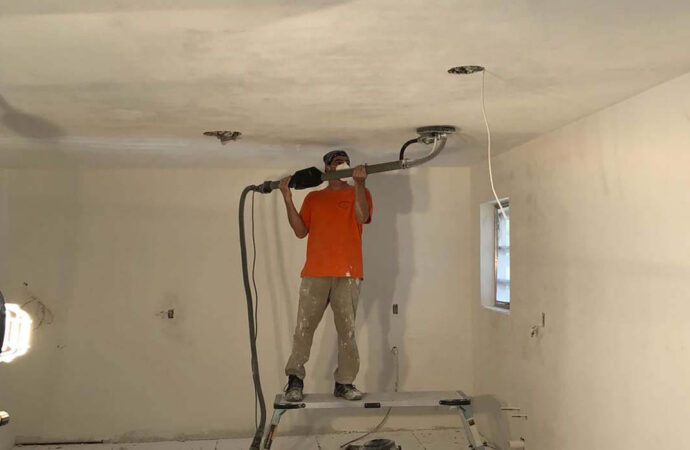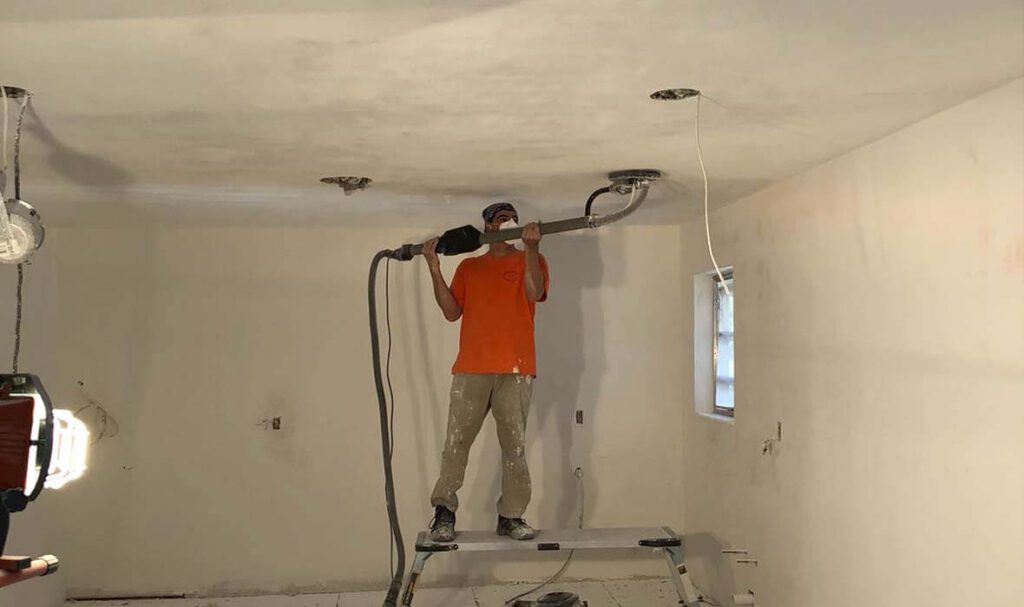Popcorn Ceiling Removal
Contact Us

It’s time to get rid of your popcorn ceilings. Unfortunately, you may be a little behind the times since the popcorn ceiling craze ended over 20 years ago. Popcorn ceiling removal can be a tedious task. Even though you as a homeowner may find it fun to do as a DIY project, it takes a lot more time, skill, and patience than most people are willing to do. It’s always best to let professional painting contractors do the work at an affordable price to save you the headaches of the potential pitfalls of doing a DIY project of that magnitude.
What made popcorn ceilings so famous?
When you have completed your weekend popcorn ceiling removal project, you will notice the sound. The appearance of popcorn ceilings wasn’t the only thing that made them famous. Their function once made them popular, known as “acoustic roofs” because they effectively muffled sound and echoes. Acoustic ceilings are a welcome auditory relief in a room with hardwood floors. However, soft furniture and some throw rugs (or carpets) can fix it.
These throwbacks from the 1950s and 80s were very popular with builders. But for a different reason, textured popcorn ceilings are great for hiding imperfections like sloppy drywall finishing work and have been complained about by new homeowners far less often.
This is the end of the list of popcorn ceiling benefits. Everyone knows the rest. They become less appealing to potential buyers as they age and fall apart. It’s time for your home to be updated.
You can save yourself headaches by taking a few precautionary measures.

It is best to test first for asbestos.
This critical step will save you time and headaches down the road. It would be best to start with an asbestos test, regardless of how you tackle the job.
Once it was discovered to be efficient in insulation and heat resistance, asbestos was cheap and easy to find. It is also very toxic. It was not banned until the late 1970s or later, depending on where you live. Therefore, it is common to find asbestos in homes built in the 1980s. One National Institute for Health Study found that asbestos-textured ceilings could be a source of asbestos exposure. Individuals exposed to ceiling deterioration may develop cancer.
The basic asbestos test can be purchased at most major hardware stores for a low price. Removal of asbestos can be expensive if you are positive. You might decide to repaint your popcorn ceiling instead of removing it. There are three ways to get rid of popcorn ceilings.
The "dry scrape" option is the second. It is possible, meaning it has been tried with different levels of success, but it is not recommended. It's not possible if you have asbestos or lead paint. This is because of the danger of airborne toxicology. It's messy. The dry scrape should not be an option if the wet scrape is available. Some people will argue that water can absorb into ceilings, causing them to expand, sag or crack. While this may be true, a wet scrape can cause your ceiling to sag. The idea behind a wet scrape doesn't involve spraying water on the ceiling but lightly misting the popcorn material to make it pull away from the ceiling. Once scraped, it will fall (rather than float). You can choose to use the dry or wet scrape method. To start, you will need a tarp and some tape. Cover electrical boxes and light fixtures, remove furniture, and tape a tarp on the floor. This will save you time, effort, and even potential damage. No matter what scraping method you choose, your ceiling will not be smooth and paintable by scraping. But you are close! Even if you remove all the popcorn material, you will likely have an uneven surface or other imperfections. This is why popcorn ceiling was so popular. There will probably be small gouges or dents to repair. You will need to use a pole sander to reach the more difficult areas. Depending on how smooth the popcorn fell off during scraping, you may need to go around the ceiling several times. One quick tip for the scraper: It's a good idea to use a file to trim the corners of your new tools. This will reduce the chances of getting divots when working on a project such as this. Finally, depending on the size and shape of the area, you might consider using textured finish paint. Make sure to use a primer coat before applying any paint. This will seal the surface and prepare you for the top coat of paint. Dry Scrape
Textured or smooth finish paint
Cover it
Before you start scraping, get your asbestos test. It is usually easy to tell the difference. If not, you can test it by soaking a small area. Grinding it becomes more difficult if it has been painted. It doesn’t matter if you have paint, lead, or asbestos. Covering popcorn ceilings from a room is the best way to remove them. You won’t have to spend much money on this, as drywall (or Gypsum Boards), a bucket with screws, and some drywall glue will only cost you a few hundred dollars, depending on how big the room is. Although this option is more time-consuming and challenging without a partner, it can still be done if you have the proper budget and are willing to rent a drywall lift.
If you decide to cover your ceiling with drywall, you will need to extend the electrical boxes to match the new drywall. There are many options for box extenders.
You can save a lot of labor no matter how big the surface is. You can save time by using scrapers designed for popcorn ceilings.
Check for Asbestos
The U.S. Consumer Product Safety Commission banned asbestos from textured paints, patching compounds, and other building materials in 1977 after it was discovered to be carcinogenic. Asbestos was used widely before the ban. It was both thermal and acoustic insulation, as well as a fire retardant.
Popcorn ceilings were often made from asbestos because of this. If your home was built before 1977 (or a little later), there might have been asbestos-laced products that were still being used for a while after the ban. Has the ceiling material been tested? The EPA-approved testing kits are about thirty-five to fifty dollars and usually return results in less than a week.
If your test results are positive for asbestos, you should leave the job to professionals. The CPSC has more information about asbestos. They say that leaving asbestos material alone is the best way to preserve it.
Prepare the Room
Take out any furniture and move it to the middle of the room. Cover with plastic sheeting. Cover any light fixtures. Using a drop cloth, you can protect your flooring and furniture from dust and dirt. Also, it is easier to clean up.
Spray the Ceiling
Spray one section of the ceiling (10 feet square) at a time. Allow it to sit for around 20 minutes. Do not over-saturate the popcorn coating, as this could cause damage to the underlying drywall.
Remove the ceiling
Protect your eyes with a dust mask and protective eyewear. Next, use a wide drywall scraper to remove popcorn coating gently.
Get rid of all the junk.
Roll up the plastic sheeting and drop cloth before applying the drywall compound. They can be taken outside and tossed in a trash bin. Lay the plastic sheeting down again, or place drop cloths on top.
Touch Up Ceiling
Use a drywall knife or a brush to apply drywall compound to problem areas. Let dry overnight. Then, lightly sand the surface with a sanding pad and a damp cloth.
Prime and paint
Use an extension attachment to paint the ceiling with a roller. Matte or flat finishes can hide imperfections, often used for ceilings. Ceiling paint is designed to be applied with minimal splatter and will not be yellow over time. You have many options for color, but white is the most popular because it reflects light into a space.
Popcorn ceilings were popular almost 50 years ago. They were decorated with bright colors and shiny furniture.
It was easy to use the spray-on spray-on technique and hand-troweled plaster. It looked almost like cottage cheese and provided noise-canceling and fire resistance. Over time, however, it became clear that popcorn ceilings were not very charming.
Popcorn ceilings can be expensive and difficult to maintain, as well as being difficult to clean and not able to withstand the elements. The speckled surfaces are considered outdated and out-of-style. It is also possible to contain asbestos, so getting rid of it is a good idea. This type of texture can be removed much more quickly than you think.
Locations We Serve
We offer the above services at the following locations within Wellington:
Additional HOAs We Service
If you are located in Palm Beach County and you don’t see your city/area listed above, don’t worry! We cover all of Palm Beach County. Fill out the contact form above or CLICK HERE and send us a message. We’ll get back to you asap!
Here is a list of our services you can get at Wellington Pro Painters & Popcorn Removal:
-
Commercial Painting Near Me
-
Commercial Popcorn Removal Near Me
-
Drywall Repair Near Me
-
Drywall Installation Near Me
-
Knockdown Texture Near Me
-
Orange Peel Ceilings Near Me
-
Residential Painting Near Me
-
Residential Popcorn Removal Near Me
-
Smooth Ceiling Finish Near Me
-
Commercial Painting Services
-
Commercial Popcorn Removal Services
-
Drywall Repair Services
-
Drywall Installation Services
-
Knockdown Texture Services
-
Orange Peel Ceilings Services
-
Residential Painting Services
-
Residential Popcorn Removal Services
-
Smooth Ceiling Finish Services
-
Commercial Stucco Installation Near Me
-
Complete EIFS Reinstallation Near Me
-
Custom Stucco and Texturing Near Me
-
Denglass Framing Near Me
-
EIFS Inspection Near Me
-
EIFS Installation Near Me
-
EIFS Wall Systems Near Me
-
Exterior Kitchen Stucco Near Me
-
New Construction Stucco Near Me
-
Stucco Application Near Me
-
Commercial Stucco Installation Services
-
Complete EIFS Reinstallation Services
-
Custom Stucco and Texturing Services
-
Denglass Framing Services
-
EIFS Inspection Services
-
EIFS Installation Services
-
EIFS Wall Systems Services
-
Exterior Kitchen Stucco Services
-
New Construction Stucco Services
-
Stucco Application Services

